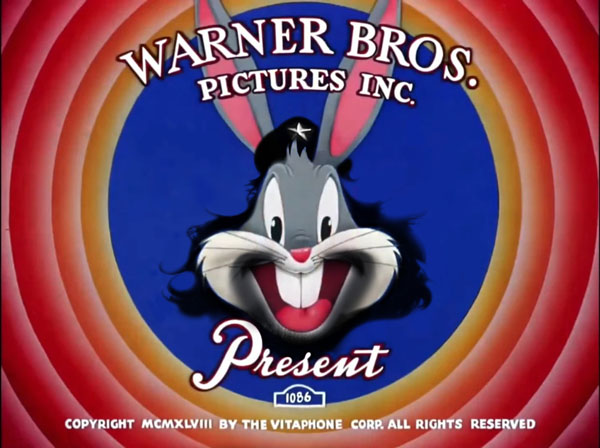
Of all the arts or techniques that are part of the cartoon universe (and cinema, in general) dubbing is the least taken into account, and for good reasons. Usually, I’d rather not understand a single word than see the thing dubbed: replacing a given actor’s vocal performance is the equivalent of watching Gene Kelly dance on crutches. And I’m not alone. Early on, USA film producers discovered that Latin American audiences preferred to see their films subtitled rather than dubbed; although in the meantime they did a lot of experiments, such as re-shoot a movie with a Spanish-speaking cast or even doing a Spanish version of the film with the same actors trying to speak in that language, which doubled the comic effect in the case of Laurel & Hardy.
Dracula (1931) in Spanish language, directed by George Melford, was shot simultaneously with Tod Browing’s version. Note this version has numerous divergences with respect to its English counterpart. (Click the NEXT button twice to see the Spanish version of the film).
Blotto (1930), short film by Laurel & Hardy. Spanish version interpreted in that language by Stan Laurel and Oliver Hardy.
In any case, dubbing seems to be an unfortunate task in which the innumerable technical difficulties will never be compensated by the results. But there are exceptions.
When television became the channel of exploitation par excellence for a large amount of audiovisual material, producers quickly realized that the poor image offered by the new medium, the small space of a screen, or the fluctuating attention span of the viewer made subtitles an unviable item. First, producers from USA, and then local ones, began to organize specialized dubbing studios in Mexico; and cartoons, short-subject series, movies or TV shows passed through them to be distributed throughout Latin America. Those Spanish dubbed versions had a particularity: they were incredibly good. For some mysterious reasons the cursed device did work, at least once. Although no one knew the names of the actors in charge at the time, one could, with a keen ear, recognize some vague similarities between the timbre of Bugs Bunny’s voice and that of Maxwell Smart. Of course, these were two totally different performances, as far removed from each other as Mel Blanc could be from Don Adams.
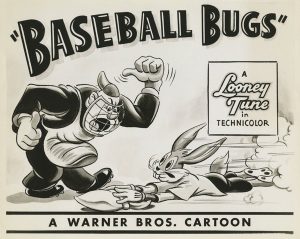 In the case of the Looney Tunes series, which is the one that concerns us, there was an additional tragic element, not attributable to the actors: the cutting of big chunks of the music score. Is evident that the original from which they worked it was composed by a single track, forcing the replacement of musical segments in any spoken part. But this minor misfortune was mitigated by the hard-working anonymous voices. The Spanish they spoke was neutral and stripped of all the Mexican particularities, since its consumption was continental, but something always managed to escape here and there. Small details, connected with the immediate reality that surrounded the actors, crept under Control’s Cone of Silence, let’s say, or appeared in the middle of a Yosemite Sam’s tirade. Little details such as, for example, some allusion to a certain massacre with hundreds of dead by some efficient repressive machinery. That is precisely what this entry is about.
In the case of the Looney Tunes series, which is the one that concerns us, there was an additional tragic element, not attributable to the actors: the cutting of big chunks of the music score. Is evident that the original from which they worked it was composed by a single track, forcing the replacement of musical segments in any spoken part. But this minor misfortune was mitigated by the hard-working anonymous voices. The Spanish they spoke was neutral and stripped of all the Mexican particularities, since its consumption was continental, but something always managed to escape here and there. Small details, connected with the immediate reality that surrounded the actors, crept under Control’s Cone of Silence, let’s say, or appeared in the middle of a Yosemite Sam’s tirade. Little details such as, for example, some allusion to a certain massacre with hundreds of dead by some efficient repressive machinery. That is precisely what this entry is about.
Warning: there is a Spanish dub made in the late nineties of this same short (along with many other entries in the series) that has all the flavor of heresy. Not to be confused with this one!
But one thing sets the dubbing of Baseball Bugs apart from the other work done by Arvizú and crew: a whole set of new meanings, evidently absent from Freleng’s original, which sneaked onto the lines of dialogue.
Here is a copy of the short with the Spanish dubbing:
And here, for the benefit of our non-Spanish-speaking readers (the majority, I guess), we have a breakdown of the main changes on dialog that I could detect.
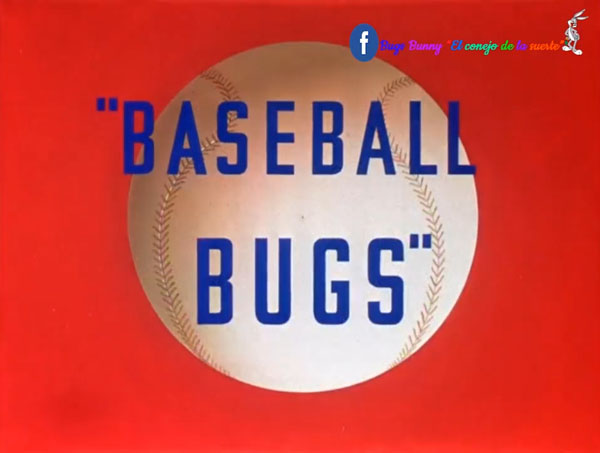
00.53- The team up to bat is the “Democrats,” “who won’t give up.” They are not to be confused with the American Democratic Party but an allusion to democracy in general. In any case, it’s far from the original “Tea Totallers”.
00.55- Player of the “Democrats”: -Sufragio efectivo, sí, aunque no sea con ron/Effective suffrage, yes, even if not with rum (an allusion to Cuban rum?)
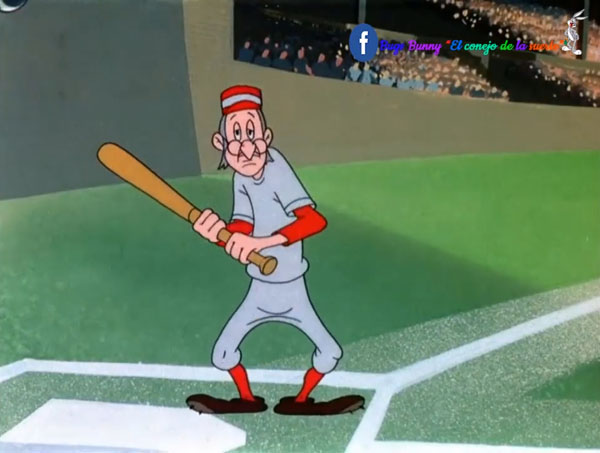
02.00- Bugs Bunny: -Bah, fuera, si serán buenos gorilas, parecen granaderos/Bah, out with them, no-good gorillas, they look like granaderos. (In Mexico, the “granaderos” were police units specialized in anti-riot duties and other internal public security functions). ¿Por qué no juegan limpio? ¡Árbitro vendido! ¿Cómo no he de enojarme? Vamos, Demócratas, acaben con esos Gorilas que no sirven más que para golpear la bola y para golpear al puebl…/Why don’t you play fair? You sellout referee! How can I not get angry? Come on, Democrats, terminate those Gorillas who only serve to beat the ball and to beat the peopl… (it is noteworthy that here, as in many other lines of dialogue, the key words are half-hidden between coughs, or pronounced in a lower tone). ¿Qué tal, amigos granader… digo, gorilas? /What’s up, friends granader… I mean, gorillas?

03.36- BB: -Ahora voy a lanzar una bola lenta, lenta, que se llama justicia social/Now I’m going to throw a slow, slow ball, which is called Social Justice.
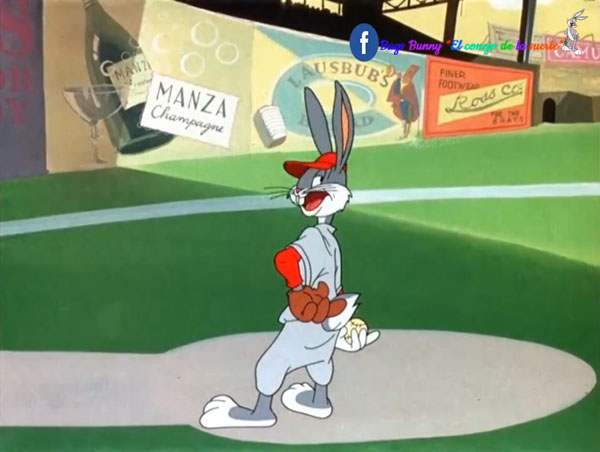
03.50- BB: -Lenta pero efectiva, la bola justicia social/Slow but effective, the Social Justice Ball.
04.02- BB: -¡Lanza tu bola represiva! /Throw your repressive ball!

04.25- BB: -¡Y esta va por el pueblo!/ This one goes for the people!
05.02- Speaker: -Justicia hasta la muerte/Justice or die (translating the “He got it” sign).
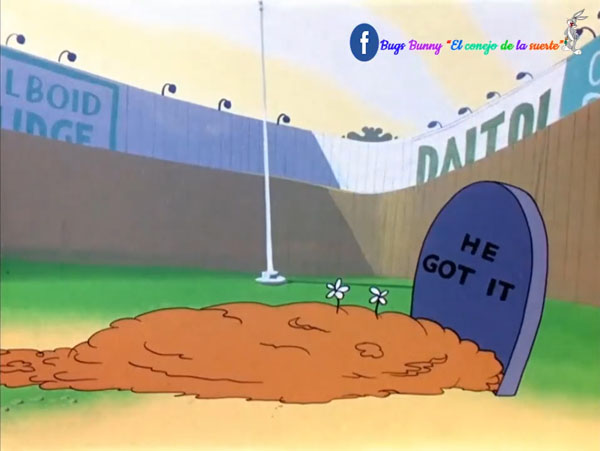
05.40- BB: -Por más grandes y fuertes que sean, siempre caen/No matter how big and strong they are, they always fall (translating a sign that reads “Was this trip really necessary?”).
06.15- BB: -Esta bola que voy a lanzar se llama La Guerrillera y lleva un efecto tan increíble que ni siquiera la van a ver/ This ball I’m going to throw is called the Guerrillera and it carries such an incredible spin that you’re not even going to see it.

07.17- Argument between Umpire and Gorilla player:
-Out!
-Who says so?
-The Statue of Liberty!
-What liberty?
Statue: -Es más fácil encontrar rosas en el mar/It’s easier to find roses in the sea.
BB: -¡No, no, no! ¡Ya me cambiaron el argumento!/They changed the script!

And they changed the script indeed, as even the rabbit himself acknowledged at the end of the short. The big question is why. As far as I remember there is no other Bugs Bunny short (or any other product dubbed by the same team) with such radical – albeit surreptitious – changes respect to the original. And since we are entering the realm of conjecture here, my money is as good as anyone’s.
My hypothesis is that the alterations sneaked in Baseball Bugs were triggered by a specific event in the face of which Arvizú and his team (and it is evident that this was a consensual operation) felt unable to continue playing the wabbit as if nothing had happened. There are no very precise dates about the dubbing of these shorts, other than that it took place “in the late 1960s”. Following this conjecture (based on intuition and thin air), we could place this particular work during October or November 1968.
According to the Wikipedia entry on the “Tlatelolco massacre”:
On October 2, 1968 in the Tlatelolco section of Mexico City, the Mexican Armed Forces opened fire on a group of unarmed civilians in the Plaza de las Tres Culturas who were protesting the upcoming 1968 Summer Olympics. The Mexican government and media claimed that the Armed Forces had been provoked by protesters shooting at them, but government documents made public since 2000 suggest that snipers had been employed by the government.
The number of deaths resulting from the event is disputed. According to U.S. national security archives, American analyst Kate Doyle documented the deaths of 44 people; however, estimates of the actual death toll range from 300 to 400, with eyewitnesses reporting hundreds dead. Additionally, the head of the Federal Directorate of Security reported that 1,345 people were arrested.
The massacre followed a series of large demonstrations called the Mexican Movement of 1968 and is considered part of the Mexican Dirty War, when the U.S.-backed Institutional Revolutionary Party (PRI) government violently repressed political and social opposition. The event occurred ten days before the opening ceremony of the Olympics, which were carried out normally.
According to Dissent Magazine (quoted in the same entry):
The year 1968 in Mexico City was a time of expansiveness and the breaking down of barriers: a time for forging alliances among students, workers, and the marginal urban poor and challenging the political regime. It was a time of great hope, seemingly on the verge of transformation. Students were out in the streets, in the plazas, on the buses, forming brigades, “going to the people.” There were movement committees at each school and heady experiences of argument, exploration, and democratic practice.
A subsidiary reason for the change on “Baseball Bugs” could lie in the fact that, since baseball is not really popular in most Latin-American countries, a change of subject could be more welcomed on this entry than others.
In any case, you never know what might happen when the Wabbit enters the field.
That’s all, folks!




 Lucas Nine is an Argentine artist: illustrator, graphic novel author, animator and director of animated films. His work has been awarded several times and published, exhibited and screened in Argentina, Brasil, Mexico, Canada, Spain, Italy, France, Germany, Hungary, Netherlands and Japan. Check out his animation and artwork online:
Lucas Nine is an Argentine artist: illustrator, graphic novel author, animator and director of animated films. His work has been awarded several times and published, exhibited and screened in Argentina, Brasil, Mexico, Canada, Spain, Italy, France, Germany, Hungary, Netherlands and Japan. Check out his animation and artwork online: 









































Whenever given a choice, I will always opt for the original sound track and subtitles.
(with the exception of narrators)
In addition to soundtrack variations and skewed meanings, dubbists are not the best people.
And before you disagree, imagine your favorite movie, with the 2 leads being dubbed by Paul Frees and Corinne Orr:
Lady And The Tramp, Casablanca, The Sound Of Music, Titanic ….
The easiest things to translate are contracts and academic papers. The hardest things to translate are song lyrics and comedy. It’s to be expected that the dialogue in a Bugs Bunny cartoon would need to be tweaked and adapted in order to yield the same laughs, in the same places, in the Spanish dub as in the English original. Even so, it’s surprising that the translation of “Baseball Bugs” was so thoroughly altered, and you make a convincing case that it relates to the political situation in Mexico at the time the dub was recorded.
While recuperating from an injury years ago I passed the time by watching the Spanish-language version of “The Addams Family” (“La familia Addams”). My Spanish is only rudimentary, but I read it better than I speak it, so between the dub and the subtitles I could make it out fairly well. What surprised me was that the names of all the characters, except Morticia, had been changed. Gomez was Homero (Homer!), Uncle Fester was Tio Lucas (Uncle Luke), Pugsley was Pericles, Wednesday was Merlina, Lurch was Largo, Cousin Itt was Tio Cosa (Uncle Thing), and Thing was Dedos (Fingers). I can understand the rationale behind some of the changes; for example, it was something of a fad in 1960s television to name female characters after days of the week because of actress Tuesday Weld, but Latin American audiences wouldn’t have gotten the joke.
It’s funny to see Laurel and Hardy speaking Spanish. I can tell you that the newspaper Stan is reading is “Yiddishe Velt” (Jewish World). There were several Yiddish-language newspapers by that name in America at one time.
I remember seeing Monty Python’s “Life of Brian” in German. In the original English, Pontius Pilate had a speech defect where he pronounces the letter R as W, just like Elmer Fudd in the Bugs Bunny cartoons; but in German, he pronounces the letter B as P, which is a fairly common speech impediment among German speakers. So where the crowd mockingly implores Pilate to “Welease Woger!”, in German it comes out “Pefreien Sie Pertolt!” (that is, “Befreien Sie Bertolt!”, or “Release Bertolt”) When there turns out to be no prisoner by that name, the jeering crowd asks him successively to release “Pernhard”, “Poris”, “Pjorn”, and ultimately “Prian”. (In case anyone’s curious, Pilate’s friend Biggus Dickus [Langus Schwanzus] speaks with a lisp in both English and German.)
So I have a few questions: In the Spanish dub of the Bugs Bunny cartoons, does Elmer Fudd have the same speech impediment as in English, a different one, or none at all? Does Porky Pig stutter in Spanish? Does Sylvester still lisp?
And in the Spanish dub of MGM’s Tom and Jerry, does the maid speak with any particular regional accent or dialect?
Very interesting observations. Being a Spanish speaker, whenever possible I do the same trick of having copies with the original soundtrack plus subtitles in the same language, in Italian, English or French movies (the ones made for the hearing impaired). It’s a great way to learn.
About the names in the Addams, your guess is right: a literal translation would have little meaning for those audiences, so an approximation is the usual choice. I should to know, since I was nicknamed “Tío Lucas” in my childhood…
About the Looney Tunes characters: the original Mexican dub was very similar to the originals voices. Elmer was given a similar pitch (but they eliminate that particular consonant substitution), Porky did stutter and Sylvester lisped as good as a lisp can be.
I forgot the Tom & Jerry’s Mammy: in the original dub, she was translated to a similar stereotypical speech, with a little cuban inflection, I guess.
Wednesday’s name in The Addams Family has nothing to do with Tuesday Weld. Rather it is an allusion to this poem:
Monday’s child is fair of face,
Tuesday’s child is full of grace.
Wednesday’s child is full of woe,
Thursday’s child has far to go.
Friday’s child is loving and giving,
Saturday’s child works hard for a living.
And the child born on the Sabbath day
Is bonny and blithe, good and gay.[1]
I think the reason for the name is now obvious
I think the rum is a reference to the Cuba Libre (aka rum & coke), since “Free Cuba” sounds like it goes with a team name of the Democrats.
“…BOGS BONNIE!”
If nothing else, today’s entry was a reminder of George Carlin’s Spanish baseball announcer routine.
Baseball is not really popular in most Latin American countries? Um, well, except for Venezuela, Cuba, Dominican Republic….
Not so many, most of it related to the Caribbean area.
Very interesting piece. Find myself thinking of Speed Racer, Kimba, and others, where dubbing was often used to deal with subject matter issues:
— “Those tranquilizer bullets will hold him.”
— “We’re being attacked by unmanned robot tanks!”
— “He passed out. He will go to jail for his crimes.” (followed by scene featuring what appears to be a grave)
I stumbled upon these old Spanish dubs by accident in my youth (and more recently, Portuguese dubs from what I presume are from the same vintage). The altered score whenever a character spoke felt like I was watching a version from a parallel universe. Bugs sounded very much like the original, in voice and attitude.
One of my Spanish students briefly explained the history of these dubs (Fantasias Animadas de Ayer y Hoy) to me a couple years back. Some older dubs of some shorts Im actively searching for.
Another radical, and slightly suggestive, alteration in dialogue was in the old dub of Bugs Bunny Gets The Boid. The dialogue between Bugs and Beaky during their dance was changed to:
Bugs: Would you like to come home with me?
Beaky: Yes, but I have to ask my mother.
Glad to see something written about these old Spanish dubs. It’s even how regional politics influenced the dialogue.
Years ago, I remember that Steve Stanchfield was all excited that he found an original “French dubbed” vintage 16mm Fleischer POPEYE cartoon. When he ran it for him and myself to see, it was a MAJOR disappointment. The dialogue was poorly dubbed, right over the original American soundtrack – whenever French dialogue was to be inserted. No attempt at akk – as I can recall – to have the “French Popeye” sound even a little like “Red Pepper Sam” or Jack Mercer.
I prefer subtitles to dubbing, with the exception of foreign films set in America (Spaghetti Westerns, mostly). Kurosawa, mainly, would be bizarre and unwatchable with our accents.
You know, the Oscar-winning animated short SUNDAE IN NEW YORK (1983) by Jimmy Picker, had a Spanish dub. There were no voice actors that dubbed in Spanish. In fact Scott Record, who did the voices in this short, dubbed the lines entirely in Spanish! I couldn’t find it. It used to be on YouTube. Now THAT is some lost media right there.
Subtitles are almost always preferable to dubbed voices, unless they’re machine generated. Certainly easier than trying to find the other language’s equivalent to Mel Blanc.
As a fellow countryman from Argentina, I grew up watching the dubbed version for years on television (ATC, or now TV Pública, was the last station to runt them) before they were moved to Cartoon Network. Tata Arvizu was a terrific dubber and even though he himself did a terrific job doing the voices of Fred Flintstone, and Maxwell Smart, or some characters in the Laurel and Hardy versions in Spanish, his work with Bugs Bunny was only restricted to the AAP package. His work in Get Smart is so good that I prefer his voice to Don Adams’ due to familiarity.
There are jokes that are impossible to translate from one language to the other and, as an example, I remember the dubbed version of Laurel and Hardy’s THE MUSIC BOX. When the nurse complains to a policeman that she was kicked in the “middle of her daily duties”, referring to her buttocks, that was replaced with “en donde la espalda pierde su buen nombre” (where the back loses its good name). This replacement still manages to make the scene funny and there are a lot of similar jokes that can be found in the dubbings of the APP Warner cartoons.
Yesterday I told a colleague of mine from Colombia about this article, and he showed me a couple of videos on his phone of some classic cartoons dubbed into Spanish: “El Pajaro Loco” (Woody Woodpecker) and “Las Urracas Parlanchinas” (Heckle and Jeckle). He said that the magpies’ Spanish names were Checho y Chucho, or Tuco y Tuco, depending on the cartoon; and that they both speak with a Mexican accent, though one of them is meant to be older than the other. These characters sounded to me very much like the Spanish dub of Bugs Bunny in “Baseball Bugs”, so I looked it up and found out that the woodpecker and the magpies were dubbed by Jorge Arvizu as well! I also learned that in “La familia Addams”, Arvizu was the voice of… Tio Lucas!
Why did you put a Che Guevara reference as if it represented Latin America as a whole? Not good.
That’s wildly unnecessary. Poor taste. Sorry.
If this US blog is going to dive into Latin American politics… Just don’t. Spare you and ourselves of the embarrassment and the controversies that arise. This is a politics-free space. Nevertheless… A bit hypocritically, I feel compelled to comment and raise controversies on this. If you go south of the Río Bravo, the concepts of left and right, social justice, oppression, liberty, and democracy aren’t as straightforward as they are in theory.
For instance: in Brazil and Argentina, the most right-leaning territories within the country as a whole or even within a single state or province are the wealthiest, more urbanized and more developed areas or municipalities; the most left-leaning are the poorest and more rural areas. The trend is reversed in the US, Switzerland, England, among other countries.
Cuban refugees in Miami are right-leaning, contrary to now left-leaning American universities.
The incumbent Panamanian president is from the same (leftist) party as Manuel Noriega (overthrown by the US in the 1989 Operation Just Cause), and is a staunch anti-abortionist. Same for Argentinian former first lady, leftist Eva Perón.
The German, Japanese and Slavic diasporas in the region are usually very right-leaning. Indeed, a descendant of Japanese Peruvian immigrants came to be elected (in a runoff against another right-winger, Vargas Llosa) president of Peru and start a political family dynasty of right-wing populists.
The left can be socially conservative and militarist, the right can be a progressive path to democracy (sometimes). Well, the situation in Venezuela can only possibily change with a right-wing (center-right, at least) coalition.
US doesn’t overthrow only left-leaning governments, they intervene against right-wing governments too, until present day.
The latest Latin American right-leaning government destabilized by the US was Sebastian Piñera’s government in Chile, that led to Gabriel Boric becoming president. Piñera’s helicopter crashed and he died just 2 days ago, you know, totally normal stuff. (I’m writing this in Feb 8th). Arguably US overthrew Brazil’s Bolsonaro government too, but that one was nuts, got hung in his own lunacy, even Piñera himself took a stand against the guy. US strongly supported Brazilian left in 2022 anyways, that’s after they launched a successful impeachment campaign against the very same Brazilian left in 2016.
Yes, you heard it right: US interference went back and forth, first foreign agents overthrew the left; then unintended consequences happened (Bolsonaro; could be worse, e.g. the Taliban!) so US foreign agents worked hard once again, but to reinstate the left. It was always a matter of strategic interests, never an anti-socialist thing (as I’ve heard from some American friends).
The marxist-leninist Latin American left isn’t ‘left’ in the same sense as the European Social Democrats, for good or for bad. The right-wing winning among college-educated people is commonplace.
I know this doesn’t have anything to do with animation, my bad.
Interesting piece of history, this Spanish dub of Baseball Bugs. The Tlatelolco massacre was perpetrated by the PRI regime. That party ruled Mexico for almost a century. They aren’t expected to come back to power in Mexico anytime soon, MORENA has a nationwide cohesive majority now, they managed to unify a country that was usually politically divided in 3 parts in the presidential election, but I’m not personally inclined to believe that the political hegemony necessarily means huge improvements in quality of life; the cartel war goes on. CIA releasing the files of the Tlatelolco massacre signals that their current methods changed a bit. Nowadays when you see a thing similar to the 1968 Mexico or France protests you can bet it’s not students rebelling against a US-backed regime, it’s US themselves backing a student protest to weaken a regime. Victoria Nuland, that is.
CIA current psyop model are the colour revolutions – joining and manipulating the young rebel groups, not repressing them. Or perhaps it was ALWAYS like this, actually?! Some scholars speculate about CIA involvement in the May 1968 protests in France. I know military people that claim the US did May 1968 to weaken and overthrow De Gaulle, and they succeeded. De Gaulle was hindering US ambitions in Europe. He withdrew France from NATO and opposed UK application to join the EEC (that would become the EU), for instance. So, I face CIA declassified documents with a bit of skepticism. The role of intelligence agencies is to manufacture things and lie to the general public. Only former officials are able to know, without a doubt, whether the Mexico protests were just an internal quarrel or whether they were another transnational destabilization plot, from US or other country (USSR?), since Mexico-US relations were apparently stable at that time.
VLLC
Very interesting commentary, not exactly related with the article, but relevant anyway, and full of nuances. it’s a worthy complement, albeit more focused in politics and history than cartoons. The mention to argentine cartoonist C Dzwonik) in the name of the commentator make me think on an fellow countryman of Argentina (allegiance perceptible also in the high voltage of the commentary). Note that the article in question has not a particular political view of the exposed facts. The “Guevara Bunny” is just a graphic gag, just like can be expected from a cartoon. “Comedy”, was the word for it.
Sometimes, these spanish dubs would be SO loud: https://www.youtube.com/watch?v=TIJAJdyLlKI (Earrape warning)